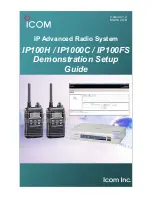
TM8100/TM8200 Service Manual
TMAA01-01 Line-Interface Board
481
© Tait Electronics Limited
November 2007
17.8
Circuit Description
17.8.1
Audio Interface
When the line-interface board is used for repeater applications, the audio
passed between the two radios must be of such a level that the message is able
to be repeated intelligibly. The audio interface is therefore capable of
handling a wide range of input and output levels (-20 to +6dBm). The
audio interface is also capable of using either a two- or four-wire isolated
interface formats, which are selectable using S1.
The input to the line driver IC (U5) is the AUDIO TAP OUT line from
the radio. This line is a software-programmabable tap point which can be
chosen from various audio signals available within the radio and is coupled
through a capacitor into the audio line out level control (RV2). This variable
resister is AC coupled into the line driver (U5) which is used in a bridged-
output format, with gain set to provide the necessary 21dB gain.
The resistors on the output of the line driver provides the necessary 600
Ω
terminating impedance, but also cause a 50% loss of signal. This is
compensated for by the higher-than-necessary gain of the line driver. Line
out protection is provided by two zener diodes, and the transformer (T1)
provides isolation.
The audio interface is capable of using a two- or four-wire interface, so a
tap is taken from one side of the balanced line out and is feed directly into
the line input level control (RV3). When using a four-wire interface, the
signal comes in through a second isolation transformer, T2. T2 is terminated
with 600
Ω
and also acts as a voltage divider. This means that the signal level
at RV3 will be identical to the level at RV3 when using a two-wire interface.
To achieve the required output level the non-inverting AC amplifier (U7)
has a gain of 10, which provides the necessary 13dB of gain. The output of
the amplifier is AC coupled into the AUDIO_TAP_IN line (pin 6 of SK2).
17.8.2
Logic Interface
The line-interface board is able to provide simple interface solutions with
other radios. Logic is used to control keying of both radios as well as
providing time delays to prevent squelch or cycling problems. The logic uses
gates rather than discrete components.
The choice of which input controls BUSY/GATE can be selected using
switches 3 and 4 of S1, while the sense of BUSY/GATE (pin 12 of SK1) can
be selected using switches 5 and 6. Switch 7 accommodates either a two-
line keying system or a single bi-directional keying line.
Summary of Contents for TM8100 mobiles
Page 1: ...TM8100 mobiles TM8200 mobiles Service Manual MMA 00005 05 Issue 5 November 2007...
Page 10: ...10 TM8100 TM8200 Service Manual Tait Electronics Limited November 2007...
Page 12: ...12 TM8100 TM8200 Service Manual Tait Electronics Limited November 2007...
Page 20: ...20 Introduction TM8100 TM8200 Service Manual Tait Electronics Limited November 2007...
Page 64: ...64 Description TM8100 TM8200 Service Manual Tait Electronics Limited November 2007...
Page 106: ...106 TM8100 TM8200 Service Manual Tait Electronics Limited November 2007...
Page 134: ...134 General Information TM8100 TM8200 Service Manual Tait Electronics Limited November 2007...
Page 168: ...168 Servicing Procedures TM8100 TM8200 Service Manual Tait Electronics Limited November 2007...
Page 464: ...464 Spare Parts TM8100 TM8200 Service Manual Tait Electronics Limited November 2007...
















































